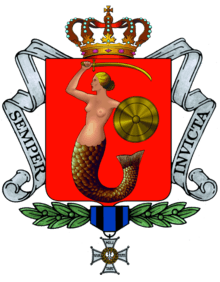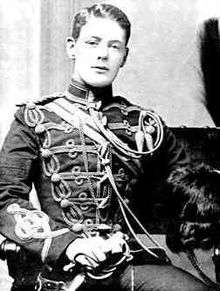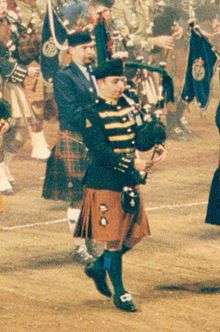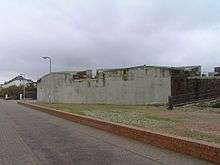Queen's Royal Hussars
| The Queen's Royal Hussars (Queen's Own and Royal Irish) | |
|---|---|
|
Cap Badge of The Queen's Royal Hussars | |
| Active | 2 September 1993- |
| Allegiance |
|
| Branch |
|
| Type | Line Cavalry |
| Role | Armoured |
| Size | One regiment |
| Part of | Royal Armoured Corps |
| Garrison/HQ |
RHQ - London Regiment - Sennelager |
| Nickname(s) | 'Churchill's Own' |
| Motto(s) | Mente et Manu, translated as "mind and hand" |
| March |
Quick - Regimental Quick March of The Queen's Royal Hussars Slow - 3rd Hussars Slow March/ Litany of Loretto/The Garb of Old Gaul/March of the Scottish Archers |
| Mascot(s) | Drum Horse (Alamein) |
| Commanders | |
| Colonel-in-Chief | HRH The Duke of Edinburgh, KG, KT, GBE |
| Colonel of the Regiment | Lt Gen Tom Beckett CBE |
| Insignia | |
| Tactical Recognition Flash |
 |
| Arm Badge |
Maid of Warsaw from 7th Hussars |
| Tartan | Saffron (Pipers kilts and capes) |
| Abbreviation | QRH |
The Queen's Royal Hussars (The Queen's Own and Royal Irish) (QRH) is the senior United Kingdom armoured regiment. It was formed on 1 September 1993 from the amalgamation of the Queen's Own Hussars and the Queen's Royal Irish Hussars. The regiment traces its roots back to 1685 and during the past 320 years has been awarded 172 Battle Honours and 8 Victoria Crosses. The regiment is currently based in Sennelager, Germany, where it is the armoured regiment for 20th Armoured Brigade, part of British Forces Germany.
History
The Queen's Royal Hussars was formed in Fallingbostel on 1 September 1993 from the amalgamation of the Queen's Own Hussars and the Queen's Royal Irish Hussars.[1]
The Queen's Own Hussars, normally referred to by the abbreviation QOH, was a cavalry regiment of the British Army, formed from the amalgamation of 3rd The King's Own Hussars and the 7th Queen's Own Hussars at Candahar Barracks, Tidworth in 1958.[2]
The Queen's Royal Irish Hussars, abbreviated as QRIH, was a cavalry regiment of the British Army formed from the amalgamation of the 4th Queen's Own Hussars and the 8th King's Royal Irish Hussars in Hohne, West Germany in 1958.[3]
The regiment, in January 1996, became the first to be deployed in Challenger 1 tanks to Bosnia with NATO's British-led Implementation Force IFOR.[4] In August 1996 the regiment deployed to Northern Ireland on Operation Banner and then moved to Athlone Barracks at Sennelager as armoured regiment for 20th Armoured Brigade in January 1998.[4] An independent tank squadron deployed to Kosovo in 2001, with the rest of the regiment deploying later that year in the dismounted role.[5]
December 2003 saw the regiment deploy once again, this time to Iraq on Operation Telic 3.[4] The regiment saw its first Military Cross awarded to Lance corporal Christopher Balmforth of B Squadron for his actions during an ambush in Basra.[6]
April 2006 saw the regiment deploy once again to Iraq on Operation Telic 8[4] and December 2008 saw the regiment deployed to Iraq on Operation Telic 13.[4] As the final Operation Telic the Queen's Royal Hussars were intimately involved in the drawdown from the main British base and spent many hours escorting convoys to and from Kuwait.[7]
In 2011 the regiment deployed on Operation Herrick 15 as a ground holding Battle Group to Afghanistan in the infantry role: they worked with the Afghan National Police handing over control of checkpoints.[5]
On return from Afghanistan in 2012 the regiment was called on at very short notice to support the Security for the London Olympic Games. The remainder of the year was used to return to the armoured role. 2013 saw C Squadron training with 5 Rifles on Exercise Baverian Charger, mounted on Challenger 2.[8] The Queen's Royal Hussars Battlegroup, comprising sub-units from 5 Rifles and 1 PWRR deployed on Exercise Prairie Thunder 2 between July and August 2013.[9]
In June 2014, the regiment deployed C Squadron to Operation Herrick 20 in Afghanistan, as the Warthog Group. This role involved crewing Warthog armoured tracked vehicles and operating with dismounted infantry from 5 RIFLES to disrupt insurgents in Helmand during the draw down of British troops from Camp Bastion. They were the last British combat units on the ground in Helmand.[10]
The regiment will move to Tidworth with 20 Armoured Infantry Brigade, forming the senior of three Type 56 heavy armoured regiments of British Army's Reactive Force.[11]
Victoria Cross
Holders of the Victoria Cross included:
- James Champion
- Samuel Parkes (4th Queen's Own Light Dragoons)
- Clement Walker Heneage
- George Hollis
- John Pearson
- Joseph Ward
- Cornet William Bankes (7th Queen's Own Hussars)
- Major Charles Fraser (7th Queen's Own Hussars)
Organization
The regiment is equipped with 56 Challenger 2 tanks.[12] In addition the Regiment also fields a squadron with a close reconnaissance troop mounted in eight FV107 Scimitars.[13]
Museums
The regiment has three museums:[14]
- The Queen's Own Hussars Museum is located at Lord Leycester Hospital in Warwick.
- The Queen's Royal Irish Hussars Museum is located at The Redoubt Fortress in Eastbourne.
- The Blackshaw Museum is located in the Regimental Guard room of Athlone Barracks in Sennelager, Germany.
The Regimental Crest & Cap Badge
The crest and cap badge are as follows:[14]
- The Regimental Crest is made up from the Angel Harp of the 8th Hussars and the Queen's Royal Irish Hussars, which is placed above the White Horse of Hanover of the 3rd Hussars and the Queen's Own Hussars. These are encircled by the Garter Belt, above which is placed the Queen's Crown.
- The Regimental Cap Badge is made up from the Angel Harp of the 8th Hussars and the Queen's Royal Irish Hussars, superimposed on the Regimental cypher of the Queen's Own Hussars, originally bestowed on the 7th Hussars in 1727; the whole is surmounted by the Queen's crown and a lion, with a scroll underneath giving the Regiment's title in blue and gold.
Privileges & traditions
In over 300 years of distinguished service the regiment has gained a number of unique privileges and traditions.
The Loyal Toast: After the Jacobite rebellion in 1745, all officers of the army were required to drink the health of the Sovereign in their mess after dinner as a token of loyalty to the King. The King, however, absolved the regiment from this duty, saying that their loyalty had always been beyond question, and gave the officers the privilege of never drinking the Loyal Toast in the Officers' Mess and of ignoring the National Anthem (they remain seated) when it is played by the band after dinner. This privilege was reaffirmed by the Sovereign prior to the formation of the regiment in 1993.[14]
- Badges and Symbols
The White Horse of Hanover: Ranking second, after the Crown, among the regiment's military badges, it was bestowed by the first three King Georges to certain regiments for their part in suppressing the Jacobites. It was first granted, as a special head-dress badge, by King George I to the 3rd King's Own Regiment of Dragoons in 1715 for their part in defeating James Francis Edward Stuart (The Old Pretender).[15]
Crossbelts: At the Battle of Almenar in 1710 the 8th Dragoons pursued the Spanish Cavalry Corps and, equipping themselves with the crossbelts of the enemy, cut down the Spaniards with their own swords. The crossbelts were worn with distinction for many years, and the nickname 'St Georges Crossbelts' was given to the regiment. Although the crossbelt worn today is based on the original 4th Hussar pattern, the continuing tradition of titling the Regimental Journal 'The Crossbelts' is in recognition of this famous action.[14]

The Maid of Warsaw: Every member of the regiment wears the Maid of Warsaw, the crest of the City of Warsaw, on the left sleeve of his No. 2 (Service) Dress. This honour was awarded to the 7th Hussars by the Commander of the Second Polish Corps in recognition of their valour in support of the Polish Forces during the Italian Campaign in World War II. Traditionally the original crest presented to the regiment is placed in front of the Commanding Officer on Dinner Nights.[14]
The Fern Leaf: All vehicles in the regiment display the emblem of New Zealand, the Fern Leaf, to commemorate the association of the 3rd Hussars with the 2nd New Zealand Division at the Battle of El Alamein where the regiment lost all but five tanks breaching the German line. This honour was granted by General Lord Freyberg VC.[14]
Kettle Drums: By command of King George II the silver kettle drums captured by The King's Own Regiment of Dragoons, later the 3rd Hussars, at Dettingen are borne by a drum horse ridden by a Sergeant Kettledrummer - both being additional to the regimental establishment. The drums are always carried at the head of the regiment on ceremonial parades and are, uniquely amongst cavalry regiments, never covered by drum banners, the battle honours being engraved directly onto the sides of the drums. In 1772 when Lord Southampton commanded the regiment, his wife gave a silver collar to be worn by the Kettledrummer, which is still worn today when parading in full dress with the drums. The present drum horse is named Alamein and its nickname is Dudley.[14]
- Other traditions

Winston Churchill: Winston Churchill, who has been described as 'the greatest Hussar of them all', was commissioned into the 4th Hussars in 1895, and later became the Colonel-in-Chief of the regiment from 1941, until the 4th Queen's Own Hussars was amalgamated with the 8th Hussars in 1958, after which he became Colonel-in-Chief of the new regiment, Queen's Own Royal Irish Hussars remaining so until his death in 1965. In recognition of this, The Churchill Cup is awarded to the top-scoring troop in the regiment's annual gunnery competition. The Commanding Officer's tank is also named 'Churchill'.[14]
- Regimental Colours
The colours are as follows:[14]
- Garter Blue: The primary colour of the regiment is garter blue. This dates from 1685 when The Queen Consort's Regiment of Dragoons, later the 3rd Hussars, wore the Queen's livery with Garter Blue feathered hats. It has been in continuous use ever since.
- Green: The use of green dates from 1748 when it was the facing colour of Princess Anne of Denmark's Regiment of Dragoons, later the 4th Hussars. It has an association with Ireland, which remains a recruiting area for the regiment. Officers and Senior Ranks wear green jumpers and all ranks wear berets. Officers can be distinguished by their distinctive tent hats (the only item of army headress worn without a cap badge other than with combat uniforms).
- Yellow: The traditional Light Cavalry colour is yellow, which has been used by all of the regiment's predecessors.
- Regimental song
The lyrics of the song go:[5]
I'm a soldier in the Queen's Army.
I'm a galloping Queen's Hussar.
I've sailed the ocean wide and blue.
I'm a chap who knows a thing or two.
Been in many a tight corner.
Shown the enemy who we are.
I can ride a horse.
Go on a spree, or sing a comic song.
And that denotes a Queen's Hussar.


The Regimental Pipes and Drums
The Pipes and Drums were inherited from the Queen's Royal Irish Hussars. There has been no formal adoption of pipe music by the regiment, but the pipe tunes have become very much a part of Regimental Parades, the following tunes have become part of the Regiment's Music.[16]
- Killaloe Composed by Robert Martin in 1887 as part of the show "Miss Esmeralda".
- The Minstrel Boy The original words were composed by Thomas Moore, set to an old traditional Irish air originally named "The Moreen".
- Highland Cathedral A modern slow melody composed by M Korb for bagpipes, it is a haunting tune used as a slow march.
- St Patrick's Day Played by the Irish Pipes at the battle of Fontenoy in 1745, though it has long been a popular patriotic Irish song.
Regimental days
The following are celebrated as battle honour days:[14]
- Dettingen 27 June
- Balaclava 25 October
- El Alamein 2 November
St Patrick's Day is also celebrated.
Lineage
| 1881 Childers Reforms | 1957 Defence White Paper | 1990 Options for Change - today |
|---|---|---|
| 3rd (King's Own) Hussars | Queen's Own Hussars | Queen's Royal Hussars |
| 7th (Queen's Own) Hussars | ||
| 4th (Queen's Own) Hussars | Queen's Royal Irish Hussars | |
| 8th (The King's Royal Irish) Hussars | ||
Alliances
Commonwealth
 Canada - The Sherbrooke Hussars
Canada - The Sherbrooke Hussars Canada - Royal Canadian Hussars
Canada - Royal Canadian Hussars Canada - 8th Canadian Hussars (Princess Louise's)
Canada - 8th Canadian Hussars (Princess Louise's) Australia - 2nd/14th Light Horse Regiment (Queensland Mounted Infantry)
Australia - 2nd/14th Light Horse Regiment (Queensland Mounted Infantry) Australia - 3rd/9th Light Horse (South Australian Mounted Rifles)
Australia - 3rd/9th Light Horse (South Australian Mounted Rifles) Australia - 4th/19th Prince of Wales Light Horse Regiment
Australia - 4th/19th Prince of Wales Light Horse Regiment Australia - 3rd Battalion, Royal Australian Regiment
Australia - 3rd Battalion, Royal Australian Regiment New Zealand - Queen Alexandra's Mounted Rifles
New Zealand - Queen Alexandra's Mounted Rifles South Africa - Natal Mounted Rifles
South Africa - Natal Mounted Rifles South Africa - Umvoti Mounted Rifles
South Africa - Umvoti Mounted Rifles South Africa - The Light Horse Regiment
South Africa - The Light Horse Regiment
Non-Commonwealth
.svg.png) Belgium - 2/4 Regiment Lansiers
Belgium - 2/4 Regiment Lansiers France - 7eme Regiment de Chasseurs
France - 7eme Regiment de Chasseurs
Affiliated Yeomanry
Order of precedence
| Preceded by Royal Dragoon Guards |
Cavalry Order of Precedence | Succeeded by The Royal Lancers |
References
- ↑ "Queen's Royal Hussars: History". Ministry of Defence. Retrieved 3 May 2014.
- ↑ "Regimental History". The Queen's Own Hussars. Retrieved 3 May 2014.
- ↑ "Queen's Royal Irish Hussars". National Army Museum. Retrieved 3 May 2014.
- 1 2 3 4 5 "Queen's Royal Hussars". British Army units1945 on. Retrieved 29 July 2016.
- 1 2 3 "Queen's Royal Hussars". British Empire. Retrieved 3 May 2014.
- ↑ The London Gazette: (Supplement) no. 57588. p. 3373. 18 March 2005. Retrieved 15 October 2011.
- ↑ "British campaign in Iraq comes to official end". Daily Telegraph. 29 April 2009. Retrieved 11 May 2011.
- ↑ Ministry of Defence (2013-03-13). "Riflemen train for post-Afghanistan deployments - News stories". GOV.UK. Retrieved 2014-05-03.
- ↑ "Canada hosts Exercise Prairie Thunder". Archived from the original on August 17, 2013.
- ↑ "Soldiers set to march through Worcester city centre to mark Armed Forces Day". The Shuttle. 26 May 2015. Retrieved 29 July 2016.
- ↑ "Regular army basing plan" (PDF). Retrieved 2014-05-03.
- ↑ "Armour". Ministry of Defence. Retrieved 29 July 2016.
- ↑ "The Queen's Royal Hussars". Ministry of Defence. Retrieved 29 July 2016.
- 1 2 3 4 5 6 7 8 9 10 "Regimental traditions". Ministry of Defence. Retrieved 3 May 2014.
- ↑ "The White Horse of Hanover". Queen's Own Hussars Museum. Retrieved 3 May 2014.
- ↑ "The Pipes and Drums". Crossbelts. Retrieved 3 May 2014.
External links
| Wikimedia Commons has media related to Queen's Royal Hussars. |
- The Queen's Royal Hussars - British Army Website
- The Queen's Royal Hussars Regimental Association Website
- Eastbourne Redoubt Fortress Military Museum
- Information from Culture24
- 4th(Queen's Own )Hussars, 8th(King's Royal Irish) Hussars Victoria Crosses
